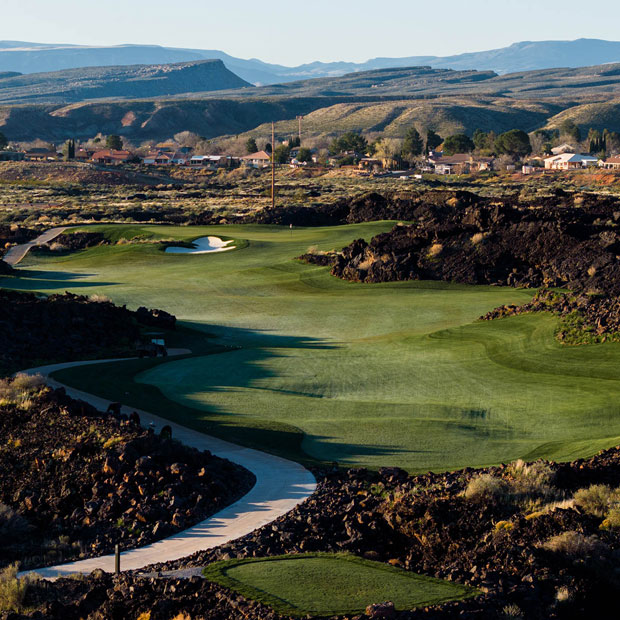Black Desert
Blasted out of ancient fields of black lava, Tom Weiskopf’s final design is visually remarkable but, in most other respects, tame

All About Black Desert
Matt McCarty, Episode 1: First PGA Tour Win at Black Desert Championship
Spearheaded by the real-estate investment company Reef Capital Partners, Black Desert Resort will soon be a city unto itself, featuring a convention center, hotels and condominiums, several restaurants, and potentially a sports arena. For the time being, however, much of the activity at this southwestern Utah destination centers on a golf course. Designed by 1973 Open champion and prolific architect Tom Weiskopf, this 18-hole, 7,417-yard course unfurls across a field of jet-black lava. In late 2020, as the design process got underway, Weiskopf was diagnosed with pancreatic cancer. He was able to finish plans for the course before his illness worsened, but his longtime design partner Phil Smith shouldered most of the on-site duties. Weiskopf passed away in August 2022, four months before construction in Utah wrapped up, making Black Desert his final design.
{{content-block-course-profile-black-desert-001}}
Take Note…
Eager host. Black Desert’s owners moved quickly to get the course TV exposure, striking multi-year deals in 2023 with both the PGA Tour and the LPGA Tour. This week’s Black Desert Championship is the first PGA Tour event that the resort has hosted, and an LPGA tournament, yet to be named, is on the schedule for next spring.
The robot apocalypse commences. In the four weeks leading up to the Black Desert Championship, the resort used a fleet of four autonomous mowers to maintain the course’s 60 acres of fairway. This, according to Golfdom, marks the first time autonomous mowing has been used in preparation for a professional golf tournament. Humans beware.
Cartball. As far as I know, Black Desert doesn’t have a rule against walking, but it might as well. The design of the course presumes that every single player will ride in a cart. My Fried Egg Golf colleague Matt Rouches recently measured some of the green-to-tee transitions on Google Earth: 235 yards from the third green to the fourth tee, 270 yards from the seventh green to the eighth tee, 250 yards from the 13th green to the 14th tee, 270 yards from the 14th green to the 15th tee, 218 yards from the 15th green to the 16th tee. Yeesh.

Coda. At the top of this piece, I called Black Desert an “18-hole” course. That’s not quite accurate. The course does have an official 19th hole, an 85-yard par 3 near the ninth green. It wasn’t open when Matt and I played the course earlier this year, but it appeared nearly finished.
Favorite Hole
No. 7, par 5, 592 yards
Lava is omnipresent at Black Desert, but no hole uses it as a psychological and strategic hazard better than the bunkerless par-5 seventh.
The tee shot is almost completely blind. A strip of turf indicates the breadth of the fairway, but the view from the tee box is dominated by mounds of lava rock (see the second photo below). While the landing zone for drives is actually quite forgiving, the player must overcome the initial intimidation factor in order to get there.
Favorite Hole
No. 7, par 5, 592 yards
Lava is omnipresent at Black Desert, but no hole uses it as a psychological and strategic hazard better than the bunkerless par-5 seventh.
The tee shot is almost completely blind. A strip of turf indicates the breadth of the fairway, but the view from the tee box is dominated by mounds of lava rock (see the second photo below). While the landing zone for drives is actually quite forgiving, the player must overcome the initial intimidation factor in order to get there.
On the second shot, the lava becomes a more tangible threat. A large bank of black rock cuts across the line of play about 120 yards from the green. The safest, most accessible target for a layup is short of this outcropping and on the right side of the fairway. From this spot, however, the approach is obstructed by lava. In order to get a clear view of the elevated green, you need to favor the left side of the layup zone, which brings another intruding ridge of lava into play.
This is an inspired hole—both beautiful and strategically compelling.

{{content-block-course-profile-black-desert-002}}
Overall Thoughts
Of the golf architects who dominated the international real-estate boom of the 1980s and 90s, Tom Weiskopf was perhaps the most restrained, consistent, and competent. His straightforward architecture has proven durable in the face of shifting trends, requiring less fixing and updating than the work of his contemporaries (see: Jack Nicklaus, Rees Jones). Weiskopf’s designs are reliable and functional; they drain well and allow for premium turf and bunker presentation. They’re well-liked among both average golfers and average tour pros
The downside? Tom Weiskopf’s golf courses can be a bit boring.
His final design at Black Desert Resort reflects this tendency toward the vanilla, but it also contains some bold touches that indicate he may have been trying to shake up his style in his later years.
Just building a golf course on a lava field was an audacious undertaking—for both the resort and Weiskopf himself. Construction was difficult, technical, and expensive, involving the blasting and reconstruction of every playing corridor. The result, however, is one of the most visually arresting courses in Weiskopf’s portfolio. From almost every significant vantage point, the player can enjoy a five-way contrast between the emerald fairways, the bright-white bunkers, the deep-black lava, the surrounding vermilion foothills, and the distant peaks of the Pine Valley Mountains. Black Desert has its issues, but visual blandness is not one of them.
Weiskopf also injected some adventurousness into his design. Whereas most of his courses have one par 4 where long hitters can reach the green from the tee, Black Desert features two: the 350-yard fifth hole and the 326-yard 14th. Both have distinctive and memorable greens. The fifth is narrow, angled, and guarded by a crescent-shaped outcropping of lava rock, while the 14th is large and undulating, sunken into a natural bowl below a rocky ridge.
On a few other holes, Weiskopf borrowed eccentric ideas from famous courses. The par-3 third hole, with its donut-shaped green wrapped around a small central bunker, is a replica of George Thomas’s sixth at Riviera Country Club. The 13th green’s low front section and high flanking shelves take inspiration from the design of the 14th green at Pebble Beach. And the par-3 17th hole approximates the geometry of Royal Troon’s Postage Stamp—bunkers short, left, and right; short-grass run-offs everywhere else.
Yet Weiskopf’s adaptations of these templates show his characteristic caution. All of them are softer than the originals: the third green is less tilted and more generously proportioned than the sixth at Riviera; the 13th green lacks the drop-off on the left side that makes the the toughest pins on the 14th at Pebble terrifying to attack from any distance; and the 17th green is about twice as wide as the actual Postage Stamp and nowhere near as difficult to hit.
{{content-block-course-profile-black-desert-003}}
It’s not surprising, of course, that Weiskopf watered down these holes. Black Desert is a resort course that will eventually average between 40 and 50,000 rounds per year. An authentic Postage Stamp would cause a daily pace-of-play crisis.
Still, the de-fanged templates are part of a larger pattern of inoffensiveness in Black Desert’s architecture. The greens are contoured, but not severely. The fairways have undulations, but the landing zones are broad and level enough that players won’t face many uneven lies. Aside from the mid-green pot on No. 3, the course has no center-line bunkers. The hazard placements are conventional and predictable. The smooth, rounded shaping of the bunkers feels neither minimalist nor maximalist, neither blended with the surrounding terrain nor boldly juxtaposed against it; Weiskopf’s aesthetics hover safely between extremes.
In other words, aside from simply existing in such an inhospitable environment for golf, Black Desert doesn’t take many risks.
Neither did Tom Weiskopf—as an architect, at least. According to his design partner Phil Smith, Weiskopf often said, “I was really controversial as a player, and I’d rather not be controversial as an architect.” His aversion to negative feedback is probably what made him a trustworthy partner to owners and developers. Weiskopf wanted to deliver designs that people liked, not revolutionize the artform. This mindset is admirably humble. But it might have prevented him from taking the big swings necessary to create great golf courses, even as it allowed him to produce many good ones, including Black Desert Resort.
0 Eggs
Using our usual criteria, some might argue that Black Desert’s otherworldly setting and immaculate turf merit an Egg apiece—one for land, one for presentation. But this would be too simplistic an approach to our rating system. The holistic assessment matters here: Black Desert lacks the overall spark of originality that I consider a prerequisite for Egg status. It is by no means a bad golf course; it’s just not an exceptional one.
Course Tour

{{content-block-course-profile-black-desert-004}}
Additional Content
“All About Black Desert” (article by Garrett Morrison and Matt Rouches)
“Golf in St. George” (reel by Garrett Morrison)
Leave a comment or start a discussion
Get full access to exclusive benefits from Fried Egg Golf
- Member-only content
- Community discussions forums
- Member-only experiences and early access to events












Leave a comment or start a discussion
Lorem ipsum dolor sit amet, consectetur adipiscing elit. Suspendisse varius enim in eros elementum tristique. Duis cursus, mi quis viverra ornare, eros dolor interdum nulla, ut commodo diam libero vitae erat. Aenean faucibus nibh et justo cursus id rutrum lorem imperdiet. Nunc ut sem vitae risus tristique posuere. uis cursus, mi quis viverra ornare, eros dolor interdum nulla, ut commodo diam libero vitae erat. Aenean faucibus nibh et justo cursus id rutrum lorem imperdiet. Nunc ut sem vitae risus tristique posuere.